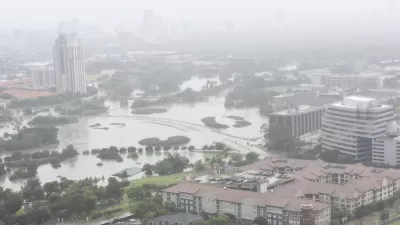I first learned of Okham’s Razor in an undergraduate economics class. Also called the Law of Parsimony, the idea states that the simplest of two competing ideas or theories is preferable to the more complicated one.
I first learned of Okham's Razor in an undergraduate economics class. Also called the Law of Parsimony, the idea states that the simplest of two competing ideas or theories is preferable to the more complicated one.
I was reminded of this principle while reading an otherwise excellent paper on water use and the urban heat island effect in the summer 2007 issue of the Journal of the American Planning Association. Researchers Subhrajit Guhathakurta and Patricia Gober asked an important question: does an urbanized area increase heat, which then puts increased demand on water consumption? The answer is a convincing "yes", at least in their test case of the desert city of Phoenix. Overall, a 1 degree (F) increase in the mean low temperature increased water consumption by 1.7 percent (290 gallons per month). Other variables were also important. Residential areas with larger lots and higher incomes, for example, tended to have higher water consumption. So did the presence and size of pools (although the effect was much smaller).
While these results are important in and of themselves, what caught my eye was their conclusion: Planning research and practice should address ways to combat waste heat in dense urban areas and consider the feedbacks between climate, water use, and the built environment. The strategies for mitigating heat island effects have been known for many years, but are little used, since air is a common resource, subject to "the tragedy of the commons" (Hardin, 1968). If heat were a regulated pollutant, as advised by some scholars, including Stone (2004), it would be within the jurisdiction of air quality management districts. [emphasis added] As we have shown, this would help conserve water, which is extremely important in arid regions such as the Phoenix metropolitan area.
Do we really need to start regulating "heat" like a pollutant? Is this really the most efficient and effective way to conserve water? I don't think so, and this is where the Okham's Razor comes in.
Irrespective of the problems inherent in determining what "waste heat" is, heat is not a "pollutant", at least in the sense that heat has an inherently negative impact on the quality of the environment. To the extent heat is a byproduct of human action, and is not fully accounted for in our transactions, it is an externality-an unanticipated or unaccounted for side effect, or spillover effect. But, it is not a pollutant. It is an unintended side effect of human activity.
More importantly, the policy goal is to more effectively regulate the use of water. Broadening the definition of pollution to include heat is, at best, an indirect strategy for regulating water use. It also runs the danger of creating yet another layer of bureaucracy within agencies that already struggle with enforcing cumbersome laws and regulations.
The real issue is regulating water use that reflects its scarcity. Other policy instruments are far more direct and less cumbersome. A more parsimonious way to address how we regulate water use is to apply market-based pricing. Rather than charge a flat fee, the rate should change with the level of demand. All we need to do is monitor water use and set rate schedules that reflect higher use rates. This can be done through block pricing, but we have the technology to price this is real time (evening sending a signal to the user about the current unit price).
Allowing the price to increase as demand goes up means consumers have more accurate signals about the true costs of using the resource and promotes conservation through the automatic and self-reinforcing feedback loops of market pricing. Pricing also encourages the adoption of alternative, more less water intensive uses (e.g., desert landscaping) as consumers seek ways to achieve the same quality of life goals through other means.

Planetizen Federal Action Tracker
A weekly monitor of how Trump’s orders and actions are impacting planners and planning in America.

Map: Where Senate Republicans Want to Sell Your Public Lands
For public land advocates, the Senate Republicans’ proposal to sell millions of acres of public land in the West is “the biggest fight of their careers.”

Restaurant Patios Were a Pandemic Win — Why Were They so Hard to Keep?
Social distancing requirements and changes in travel patterns prompted cities to pilot new uses for street and sidewalk space. Then it got complicated.

Platform Pilsner: Vancouver Transit Agency Releases... a Beer?
TransLink will receive a portion of every sale of the four-pack.

Toronto Weighs Cheaper Transit, Parking Hikes for Major Events
Special event rates would take effect during large festivals, sports games and concerts to ‘discourage driving, manage congestion and free up space for transit.”

Berlin to Consider Car-Free Zone Larger Than Manhattan
The area bound by the 22-mile Ringbahn would still allow 12 uses of a private automobile per year per person, and several other exemptions.
Urban Design for Planners 1: Software Tools
This six-course series explores essential urban design concepts using open source software and equips planners with the tools they need to participate fully in the urban design process.
Planning for Universal Design
Learn the tools for implementing Universal Design in planning regulations.
Heyer Gruel & Associates PA
JM Goldson LLC
Custer County Colorado
City of Camden Redevelopment Agency
City of Astoria
Transportation Research & Education Center (TREC) at Portland State University
Camden Redevelopment Agency
City of Claremont
Municipality of Princeton (NJ)






























